The “ghosts” of 1328 Smith Ridge Road began appearing soon after Jennifer Holme and David Markatos bought the historic home 16 years ago.
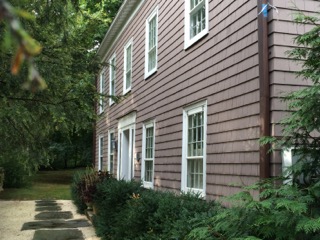
The front of 1329 Smith Ridge Road in New Canaan. Contributed
A ca. 1742-built, wood shingle-clad house whose rich history stretches back six decades before New Canaan’s incorporation, the prominent maroon-colored structure sits close to the road—as is common for antiques—and is one of the last homes that northbound motorists pass before crossing into New York State.
Holme, who works in finance, and Markatos, a lawyer, are northern Westchester natives and the house was the first they purchased together as a married couple.

From a story board prepared by Jennifer Holme: “The Comstock House on Smith Ridge, just south of the New York State line in New Canaan, Conn. The view is looking north. There were three families living in it when Dorothy (Docie) and Addison Burnham bought it. Docie remembers that the house, land and associated barns cost about $20,000. The photo was taken in 1936 just before the sale. The house had two huge chimneys and many fireplaces. Part of the house goes back to 1782. Some time around 1812 and 1813 it was enlarged to roughly the same size seen here. At one time it was owned by Samuel Comstock. When Docie and Addison bought it, and for another 22 years, several neighboring dairy farmers still cut the surrounding fields for hay for their herds. This meant the sloping field across the swampy area to the west of the house was wonderful for winter coasting.”
“What happened was, sort of serendipitously, whenever there was a high school reunion or things like that, we’d get letters in the mailbox from people who used to live here asking if they could stop by,” Markatos recalled on a recent afternoon, standing in front of an original mantle in this lovingly preserved front room (likely a classic salt box in its original construction). “Or people would happen to come up to the house or drive by to see what was going on in town, and they’d want to see the place, to see if it’s still standing.”
It is, and Holme and Markatos since taking over have re-pointed the foundations of the main house, redone the roof and chimneys, remodeled the kitchen and master bedroom and replaced the deck.
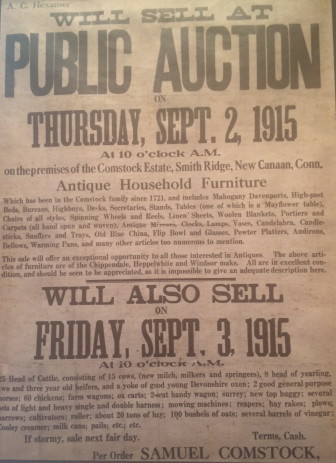
Notice of a Public Auction for the home and items of 1328 Smith Ridge Road, an 18th Century home that, until that point, had been the property of the Comstock family. On Saturday, Sept. 12, 2015, the home’s current owners and residents, Jennifer Holme and David Markatos, hosted members of families that had occupied the house from the 1930s through 1970s for a remembrance and story-sharing get-together. Contributed
This month, the home reached an important milestone: It’s been exactly 100 years since its original owners, the storied Comstock family, auctioned off the property, according to a notice that Holme and Markatos unearthed in the research they began undertaking soon after moving in.
To mark the occasion, Markatos got the idea to invite those who had owned and occupied 1328 Smith Ridge Road through the decades to come back for a remembrance and stories-sharing session. And so on Saturday, Sept. 12, members of two families that had lived there from the 1930s through the ‘70s were invited “back home.”

L-R, standing: Choux Smith, Patrick Smith, Bet Zimmerman Smith, David Markatos, Jennifer Holme, David Burnham. Sitting: Daniel Burnham. Contributed
They include David Burnham, an award-winning and pioneering investigative and data journalist widely known for breaking the NYPD Officer Frank Serpico whistleblower story with a front-page article for the New York Times on April 25, 1970—more on the remarkable Burnhams below.
“We decided when we saw the [auction] poster that it was important to celebrate 100 years since the last Comstock lived in the house,” Holme said. “It’s a moment in time that we thought should be celebrated. We said, ‘Let’s have a party, because this can’t happen again.’ ”
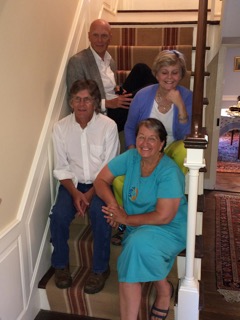
Back row: Taxi Smith and Choux Smith. Front row: Patrick Smith and his wife, Bet Zimmerman Smith, at a party in September 2015 that marked 100 years to the month since the property was auctioned off the home and items at 1328 Smith Ridge Road, which had at that time been in the Comstock family for nearly 200 years. Contributed
Holme and Markatos, who moved up here from Manhattan and had looked at both Darien and Stamford before settling on New Canaan, say they do not consider themselves “historic preservationists,” strictly speaking—rather, they believe in an “invisible hand” approach that sees updates (such as central air) come into the house without detracting from its significant physical or cultural heritage.
In some ways, the gathering of former residents this month marked the culmination of the couple’s research and connection with visitors as well as their careful stewardship and restorative work.
“I think for us, we wanted to be sensitive to the house and, as time went on, we had to make decisions about renovating the house and we also became more and more immersed in the history of the house and the people of the house,” Holme said. “And so we learned about the Smiths and Burnhams. We knew about the Achenbachs. So as people came and we were trying to do work on the house and also trying to be sensitive to the architecture, the use of the house, we decided to not knock down walls and make it a big open space.”
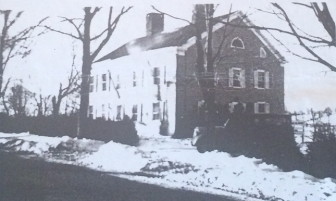
From the story board: “Another photograph of the Smith Ridge house, this one shortly after restoration by Dorothy and Addison, probably about 1940 or 1941. Photograph was taken looking to the southwest. The sloping field in the background was where Dan, Sue and David coasted in the winter.”
Markatos said he was unaware upon moving to New Canaan of “the richness of the community,” but that as time passed and he learned more about the Comstocks and agricultural history of the area, the home at 1328 Smith Ridge Road took on more meaning.
“This [house] really embodies New Canaan from the beginning, when the first census happened,” he said. “The Comstocks were a very important family in this part of Connecticut, so this is their legacy. Three of their sons who fought in the Revolutionary War grew up in this house.”
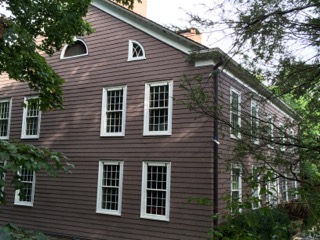
1328 Smith Ridge Road in New Canaan. Contributed
An article in the “Landmarks of New Canaan” book, published in 1951 by the New Canaan Historical Society, identifies it as the “Comstock-Burnham House.” In December 1772, the Rev. William Drummond spent the first night in New Canaan at the house and there began the famous “Visitation” census.
According to the article, by John G. Pennypacker, the family of Abijah Comstock then was living there (including a son, Samuel, who would go on to operate a distillery on Smith Ridge, we learn from Mary Louise King in her “Portrait of New Canaan”) with his four children and two slaves. Abijah’s father Moses had been an early settler of Silvermine and when his son turned 23, gave him 30 acres up the valley, Pennypacker writes.

Gingerbitz on Elm Street made the cake for the “reunion” party of families that have occupied the historic home at 1328 Smith Ridge Road. Contributed
“Abijah prospered and began the practice of buying land and keeping a ‘dry herd’ at the north end of Smith Ridge, near the headwaters of Five Mile River. Between 1748 and 1766 he accumulated 90 acres of land from the earlier settlers in this neighborhood, on both sides of the Smith Ridge Road, running south from Puddin’ Hill Road (which marked the colony line) and as far west as Luke’s Wood Road. Meanwhile, his older sons, Thomas, David and Enoch (all of whom later fought in the Revolution) were growing up. Abijah’s wife died in 1770 and this may have been what decided him, unlike most fathers of his time, to move himself to his outlying and broader acres and to turn over the management—and later the ownership—of his original farm to his son, Thomas.”
Abijah Comstock then built the house which, “with subsequent additions and alterations, became the Burnham house,” Pennypacker writes.

Dorothy Moore Burnham, right, and Beatrice More, later married to Frank Barker Chase. Sitting on rocks to the south of the house at 1328 Smith Ridge road. Dorothy and Addison had bought it but not yet moved in. The year was 1935 and Dorothy was 36 years old. Contributed
Those alterations include the electricity that Dorothy “Docie” Moore Burham (David’s mother) installed in the 1940s, according to Holme. In getting that work done, she came across a box which yielded many of the historical documents that ended up at the Historical Society, and copies of which were set into three large storyboards that Holme (once a member of the New Canaan Preservation Alliance) created for the Sept. 12 gathering.
Her husband, Addison C. Burnham Jr., had been born and raised in Massachusetts and would graduate in 1919 from Harvard College, according to a biography in “New England Aviators 1914-1918” (which also was featured on a storyboard). Burnham Jr. enlisted in 1917, attended the Naval Aviation Ground School at M.I.T., and was ordered to France in May 1918. He would serve through the following February, earning the Navy Cross prior to his release from active service.
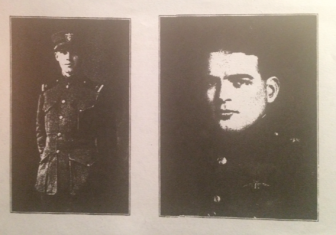
Addison C. Burnham Jr. was awarded the Navy Cross in 1920 for his heroics in World War I. He later would move his family into the house at 1328 Smith Ridge Road in New Canaan, and one of his sons is David Burnham, an award-winning journalist.
Two Burnham children, brothers David and Daniel, traveled from as far as Maine to attend the gathering, as well as four members of the Smith family, who purchased and moved in after the Burnhams, in 1955. They came to the get-together from as far as North Carolina, Markatos said.
Among the documents that Holme and Markatos have discovered in their research—including with assistance from David Burnham, who they said is also transferring a rich oral history on the house—are a 1721 bill of sale for a 12-year-old slave, that same slave’s will 52 years later (the Comstock family is said to have owned the last slave of Connecticut, Onesimus Comstock, whose gravestone can be found in a small burial yard off of Laurel Road), a document marking the emancipation of a different slave, a dowry for one of Abijah’s daughters (who would marry one of Norwalk’s two representatives in the legislature), family trees, census records and even an inventory of cows (“He [Abijah] was always counting his cows,” Holme said).
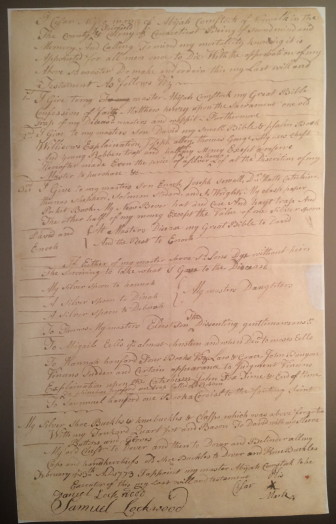
A June 16, 1797 document emancipating the slave Rose from a family and property that included home at 1328 Smith Ridge Road. Part of it reads: “Know all men by these presents that I, Abijah Comstock of Norwalk in Fairfield County and State of Connecticut do hereby emancipate my Negro Servant Woman named Rose and by these Presents fully, freely and Absolutely Discharge said Negro from all Obligation to serve me or my Heirs for ever.”
The Comstock family in this area goes back at least as far as the 1660s in Norwalk, historians say, and they would occupy the house at 1328 Smith Ridge Road continuously from the time of its construction in the 1740s through 1915. Abijah’s son Samuel took over the house and farm on his death in 1807, and when that Samuel died, his youngest son—also a Samuel—was helping his mother run the farm.
He did well, according to Pennypacker.
“By 1837, Samuel 2nd was shipping more hay to New York than any farmer in town,” the author writes in the “Landmarks” book. In this era—a high time of agriculture in New Canaan—Smith Ridge operated in some ways as its own self-contained village, with a store, post office, cobbler’s shop and blacksmith, among other sites, Pennypacker writes. Yet within 10 years of the close of the American Civil War—by then Samuel II’s son, Samuel III, had taken over the farm—agriculture was on the decline.
“On Sundays, however, the neighbors could still tell what time it was when they saw Samuel [III] and his sisters”—he had four—“drive by in the ‘canopy top’ on their way to church, where it is said they invariably arrived twenty minutes late.”
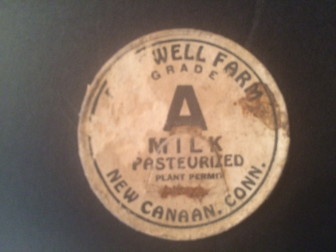
Deepwell Farm milk bottle cap, unearthed in the historic home at 1328 Smith Ridge Road.
The auction itself draws a note from Pennyback, who reports second-hand that “such a collection of beautiful antiques, in perfect condition, will never again be offered by its hereditary owners.”
According to the auction notice, those items include Chippendale, Heppelwhite and Windsor furniture, woolen blankets, candelabra, antique mirrors,, old blue china, snuffers, vases, pewter platters, bellows, warming pans “and many other articles too numerous to mention.”
The home, once sold, would have only “casual tenants,” Pennypacker writes, until the Burnhams purchased it in 1936.
Holme and Markatos are the third owners since then. They say the timing of the gathering was right for them because they feel comfortable with the work they’ve done bringing former residents back into the home.
And though some features of the original house may have been stripped following its sale—perhaps including stonework, doors and hinges—unique touches such as door frames and mantles remain, as does a sense of remoteness on the 2-acre property that recalls the original Comstock farm.
“It’s a very private setting, so we like that,” Markatos said, standing on the back deck which offers a fine vantage point, overlooking a wide yard that slopes down toward a swimming pool.
“We like the old trees and old stone walls,” Holme added.
Thank you for this fabulous story! It is so great to know that this treasure is in great hands and being cared for and celebrated.
We had a high school Post Prom Party there.
Great article. These are the articles that make The NewCanaanite the best news source in town!
Thanks so much, Kristen! If you like this type of story, you will love our Downtown & Holiday Guide, launching after Thanksgiving—stay tuned.
The house has a lot of New Canaan history. I can’t imagine the personal events that touched peoples lives living in the house. Susan Burnham Edwards would talk about grabbing a tray and sledding out of the second story window. What fun memories.
Thank you for the gathering, thank you for the
article, a pleaser reading it.